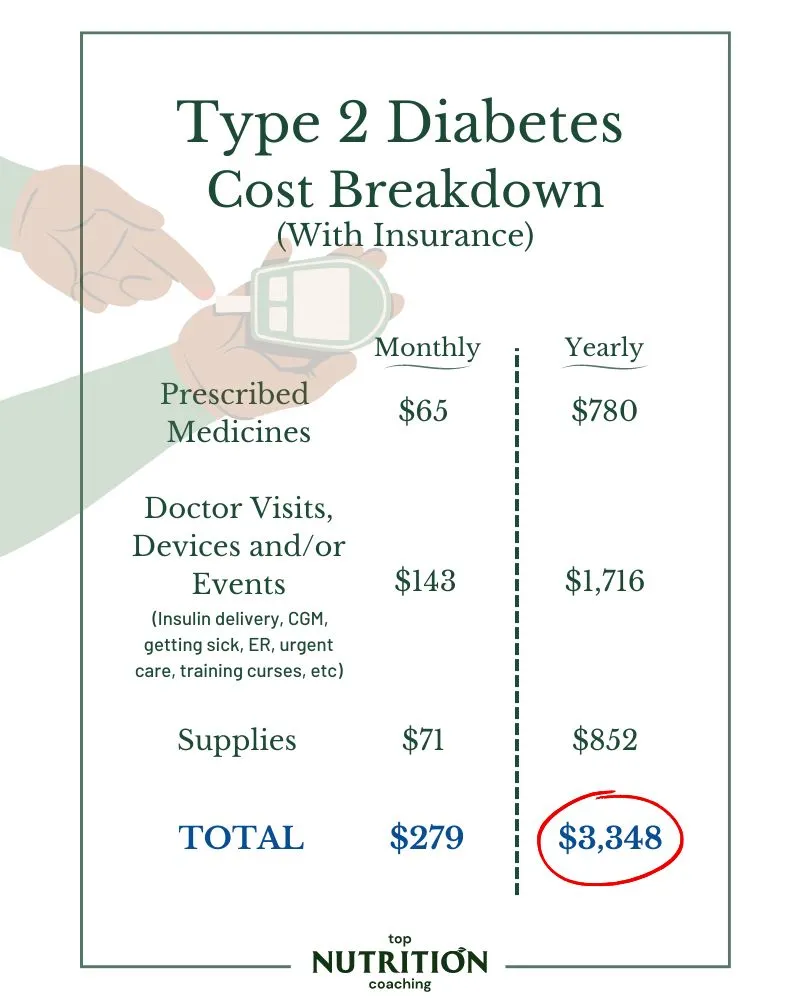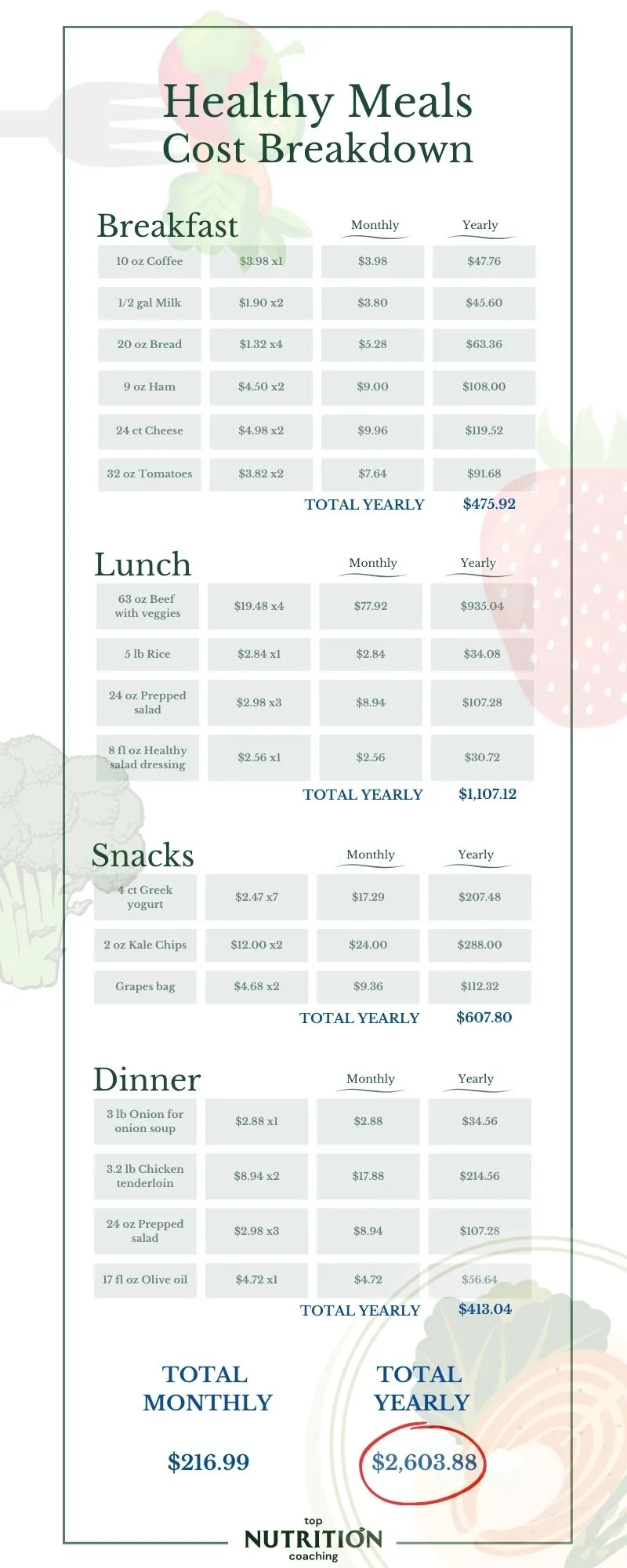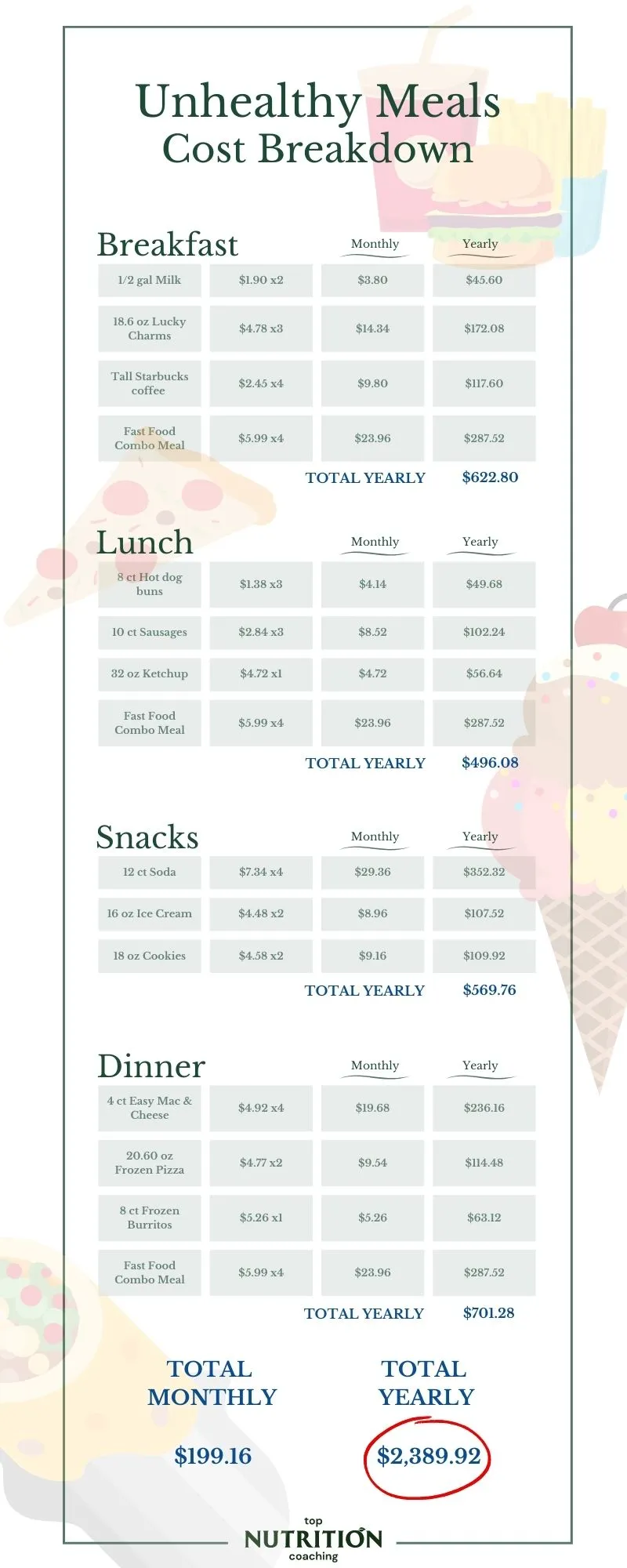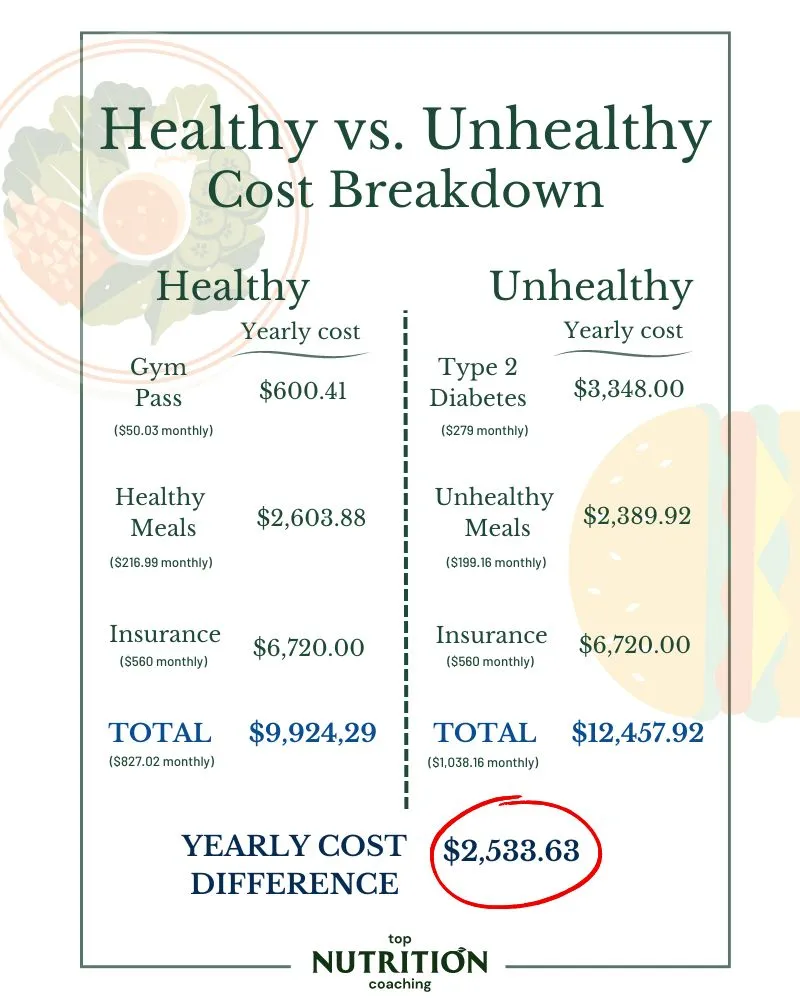It's no secret that healthy habits are costly, but unhealthy living costs more in the long run. Being unhealthy is associated with high medical expenses, decreased quality of life, and lost productivity. Still, anyone can avoid these burdens by making healthy choices and following nutritious eating habits.
Top Nutrition Coaching believes in making healthy living more accessible, so we researched and calculated the costs of being unhealthy in 2023. We'll look at the essential findings and how the long-term costs exceed the price of a healthy lifestyle, from the costs of type 2 diabetes to the hidden toll on the quality of life.
Cost of Having Type 2 Diabetes

Type 2 diabetes is the most common type of diabetes, affecting millions of people worldwide, including one in every ten Americans. While genetics and other factors play a role in its development, an unhealthy diet and lifestyle may pose the most significant risk.
This condition occurs when the body resists insulin, a hormone that aids in the processing and regulating of blood sugar. When the pancreas fails to produce enough insulin, blood sugar levels rise, resulting in fatigue, tingling, blurred vision, and other symptoms.
Type 2 diabetics can expect to pay nearly $280 or more each month for medication, doctor visits, and other medical expenses, representing a 50% increase over the cost of insurance alone. This amounts to more than $3,300 over the course of a year, not including indirect costs such as decreased quality of life and lost productivity.
However, anyone can avoid the costs of type 2 diabetes by living a healthy lifestyle and practicing nutritious eating habits. For example, fatty acids, sugar, and refined carbohydrates can cause insulin resistance, so avoiding or reducing these ingredients can help decrease the risk of developing type 2 diabetes. Similarly, fast food contains high levels of processed ingredients, sodium, and unhealthy fats, all of which can increase insulin resistance.
In comparison, foods such as nuts, fruits, and whole grains have been shown to reduce the risk of diabetes. While healthy foods are a bit more expensive than unhealthy alternatives, they pay off in the long run and do wonders for your health, lowering the risk of type 2 diabetes and the extra medical costs.
Cost of Healthy vs. Unhealthy Meals


It's no secret that healthy foods like vegetables, yogurt, and organic chicken are more expensive than unhealthy options like fast food. While purchasing unhealthy meals can save money in the short term, the overall cost of living rises as the body's health deteriorates.
For example, a high-sodium diet increases the risk of developing high blood pressure or cholesterol, both of which are major causes of heart disease and stroke. The average diet requires less than 2,300 mg daily, but unhealthy meals contain far more, sometimes exceeding the daily recommended intake in a single serving.
On the other hand, investing in a healthy diet can help prevent chronic health conditions, resulting in lower healthcare costs and a higher quality of life. While they are more expensive, the following food groups can contribute to a well-balanced diet:
- Above-ground vegetables (zucchini, broccoli, and asparagus)
- Nutrient-dense fruits (apples, bananas, and mango)
- Low carbohydrate foods (beans and whole grains)
- Lean proteins (fish and low-fat chicken)
It is essential to keep in mind that investing in a healthy diet does not have to break the bank. Meal planning, purchasing in-season local produce, and selecting less expensive sources of lean protein can all help you save money on groceries. Similarly, cooking nutritious meals at home can help you spend less on eating out at restaurants.
Overall, the long-term savings and benefits of eating healthy meals outweigh the short-term cost advantage of eating unhealthy meals. With rising insurance costs and high medical bills, unhealthy eating takes a significant financial toll, which can be prevented by following a healthy diet.
Cost of Being Healthy vs. Unhealthy Overall

Living a healthy lifestyle can appear to be a daunting task, especially when considering the costs involved. Investing in your health, on the other hand, can pay off in the long run and prevent additional medical costs.
Obesity, type 2 diabetes, high cholesterol, and cancer are just a few of the chronic health conditions that unhealthy lifestyles and diets can cause. The monthly and annual costs of treating these conditions are not cheap; for example, type 2 diabetes can cost nearly $3,350 per year, if not more. This does not include the costs of other chronic health conditions, which can be much higher.
In comparison, the cost of being healthy is quite valuable. A gym membership costs about $50 per month or $600 per year and promotes healthy living. Exercise has been shown to lower the risk of chronic diseases while also keeping you active and healthy. While it may appear more expensive in the short term, committing to wholesome routines reduces medical costs in the long run.
Even if the insurance cost is the same for healthy and unhealthy lifestyles, this does not account for additional medical expenses such as significant procedures, additional copayments, and medical supplies that are not covered by insurance.
While either healthy or unhealthy people can encounter health issues throughout their life, healthy people are far more likely to save money and cut medical costs in the long run. Of course, a healthy lifestyle necessitates slightly higher-priced groceries and a gym membership, but the peace of mind and future savings are priceless.
Other Costs of Being Unhealthy: The Hidden Toll on Quality of Life
As we've seen, the financial costs of being unhealthy can be substantial, but the hidden cost in terms of quality of life is frequently overlooked. Poor health can have an impact on many aspects of life, including overall happiness, productivity, capabilities, and energy levels. Aside from the financial costs, unhealthy lifestyles have indirect costs that are more significant than monetary costs.
According to one study, healthier employees of normal weight are less likely to miss work than those who are obese. Similarly, employees with families who practice healthy habits are less likely to have to care for sick family members as frequently.
Low energy and productivity make it challenging to complete tasks and focus, leading to lower income and job satisfaction. Furthermore, these factors have an impact on personal finances and job security, resulting in added stress and a lower quality of life. Unhealthy lifestyles may also result in physical limitations, such as the inability to participate in certain physical activities or travel.
On the other hand, investing in a healthy lifestyle can result in significant improvements, resulting in a more fulfilling, open, and satisfying life. Anyone can improve their physical and mental health by prioritizing health and wellness, which cannot be purchased. While the financial benefits of unhealthy living may appear appealing in the short term, they quickly add up and result in several additional costs, both financially and in terms of life quality.
Methodology
We reviewed and analyzed various sources reporting on insurance and health costs. We used the following sources, among others linked within our report, estimate the cost of insurance, medical care, and gym memberships.
- Insurance: How much will health care insurance premiums increase in 2023?
- Gym membership: Average Gym Membership Costs $50.03 per Month [2022 Gym Price Research]
- Diabetes medical costs: The Cost of Type 2 Diabetes
To keep prices standard and comparable between unhealthy and healthy meals, we used the individual cost of food items as sold by Walmart, which is a widely accessible resource across the nation, to calculate examples of meals for healthy and unhealthy lifestyles.
















.jpeg)



